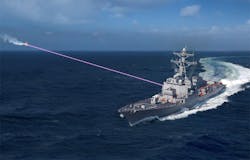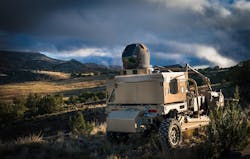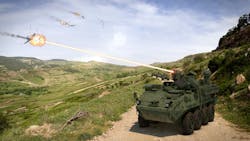High-energy laser weapons move quickly from prototype to deployment
By Megan Crouse
NASHUA, N.H. - When it comes to defending against oncoming missiles, laser weapons could provide a precise way to target and destroy from aboard a vehicle or ship. Laser weapons can defend against a mortar, which does not have a guidance system, or against a sophisticated drone. They travel at the speed of light and can be tuned to produce as little or as much damage deemed appropriate for the situation. In addition, they have a low capacity for collateral damage, since the size of the beam is so small and precise.
With all these capabilities, however, sometimes it seems that news of laser weapons has been played out. Since the 1960s, engineers and science fiction writersU.S. Navy leaders today are beginning to deploy working lasers and figure out how to integrate them into existing military weapon systems. In November 2020 Rob Afzal, Lockheed Martin Corp. senior fellow of laser and sensor systems explained why, despite being around almost as long as rocketry itself, it has taken so long for today’s militaries to deploy laser weapons. “The issue, though, was that those systems were basically just too big, literally. They were physically too big to really be deployed in the tactical environment, on a truck or on an airplane, even on a ship, without taking up large portions of the ship.”
Now, that’s changing. In a test around this time last year the Navy used a solid state laser — technology maturation (SSL-TM) laser weapons system demonstrator (LWSD) MK 2 MOD 0 from the amphibious transport dock ship USS Portland (LPD 27) to shoot down an unmanned aerial vehicle (UAV) during tests.
So, what is the state of laser technology today? And has science fiction truly become reality, or is it still all talk and hopes? Where and by who are they currently deployed?
The U.S. Army, Air Force, and Navy all have applications and equipment for laser systems today. In 2020 Army leaders announced they will be testing 50-kilowatt lasers mounted on Stryker wheeled combat vehicles. Built by two subcontractors, Northrop Grumman Corp. and Raytheon Technologies Corp., and prime contractor Kord Technologies, these Directed Energy Maneuver Short-Range Air Defense systems, or DE M-SHORAD, will begin testing this summer.
The Navy’s littoral combat ship USS Little Rock has a 150-kilowatt laser weapon, likely Lockheed Martin’s $150 million High Energy Laser and Integrated Optical-dazzler and Surveillance (HELIOS), or the Surface Navy Laser Weapon System (SNLWS) Increment 1, making it the fourth Navy ship with such a system. This was a relatively easy meeting of ship and system, since both were made by Lockheed Martin.
While some of these laser weapons are offensive, others are dazzlers, made to confuse and blind sensors on other ships, aircraft, or flying missiles. These can burn out a vehicle’s cameras without pursuing an aggressive action. The guided missile destroyer USS Dewey, for example, has been fitted with a weapon that is known as ODIN, or Optical Dazzling Interdictor. This essentially blinds drones and causes them to crash. HELIOS can do both, combining dazzler capabilities with actual destruction.
There are some limitations as to what system can go on what ship, naturally. Not all ships can support the 150-kilowatt class systems. This is just one of the areas in which implementing laser weapons is a process in flux, as the Navy and other branches and manufacturers work on making integration with existing vehicles practical.
In a 2021 report, the Congressional Research Service named one of the use cases for lasers on ships as “potential combat situations against adversaries, such as China, that are armed with large numbers of missiles, including advanced models, and large numbers of UAVs.”
Lasers could solve two problems of combatting missiles and unmanned aircraft: restricted amounts of ammunition for surface-to-air missiles and Gatling guns, or unfavorable costs.
Since solid state lasers are powered by electricity, they could be fired indefinitely as long as the ship and the laser are operating properly. They also cost less and can defend against small boats and UAVs that might otherwise take from the pool of limited ammunition. Solid-state lasers ideally can counter fast-moving targets with precision, and offer the variability to be used for different responses from simply monitoring targets to causing major damage.
A brief history of high-energy lasers
The U.S. military has had electromagnetic spectrum weapons in mind since the 1960s. Throughout the 1980s, industry and military laid the groundwork for figuring out how to reach practical power levels, beam control and adaptive optics. The Department of Defense officially recognized lasers as a plausible future weapon in 1999, marking the beginning of formal research and development.
Of course, to know what today’s lasers need when it comes to their onboard electronics, we need to know how a laser works in the first place. Technically a little-known acronym for “light amplification by stimulated emission of radiation,” lasers emit directed coherent light of a single wavelength.
When we refer to a solid-state laser, we’re specifying the source of power used to excite the photons that make up the beam. In a solid-state laser the tasing mechanism is a rod made up of a solid medium, such as glass, crystal or a gem, and an active material such as chromium, titanium or others. Alongside being weapons themselves, these are often the type of lasers used on range finders and target designators, since they can be made to fit in small spaces, are relatively inexpensive, and can run on batteries.
Today’s optical fiber lasers also are technically solid state, using optical fibers as the gain medium. They’re more rugged than older solid-state lasers, and don’t require a clean room to operate or be maintained.
The Navy’s first use of a prototype solid-state laser was in 2009, a laser weapon system which was tested against drones and had a reported beam power of 30 kilowatts. The amphibious transport dock ship USS Ponce carried an AN/SEQ-3 Laser Weapon System (LaWS) in August 2014 to test the system against swarming boats and swarming UAVs. At that time, it was considered “operational.” From there it was replaced with another ship and the LaWS removed to be refurbished as a test asset for the HELIOS system.
New Threats
New and different threats also make high-energy lasers more practical than they were before.
“High-energy laser systems are a better match to the threats we now face versus the threats 10 or 20 years ago,” says Iain McKinnie, director for science and technology at the Raytheon Intelligence & Space segment in McKinney, Texas. “A lot of low-end threats have become much more widely available, more proliferated and widely available. I’m thinking of class 1 or 2 drones that can be armed or used as targeting assets, but also rockets, artillery or mortars. Lasers are really well-suited to deal with threats not particularly hardened, not particularly difficult to kill from a laser standpoint. Also depending on how they’re operated they have a very large or infinite magazine.”
In the past. lasers have been considered to be a way to defend against ballistic missiles, McKinnie says. However, that’s still a difficult application and doesn’t take advantage of the large magazine.
SWAP problems and solutions
“What is ironic about the recent attempts is that although I think the technology demonstrators were successful, meaning the system could be put together, andBut three things have changed. First, he says, the development of fiber laser technology has enabled the systems to be “the most efficient at converting electric power into a high-power beam, which means your electrical power systems and waste heat systems are minimized because efficiency is high.” Second, the beam is of high-quality. Third, the commercial industrial base now can provide many of the core components.
Lockheed Martin developed the ability to combine the output of a large number of individual fiber lasers instead of trying to build a bigger single beam, says Lockheed Martin’s Afzal.
Commercial influence
There are several ways that commercial laser technologies have influenced military laser weapons. Fiber-optics became widely used in communications, and fiber-laser cutters allowed for industrial cutting, welding, and drilling more cost-effectively. Building smart phones and other small electronic devices required very high beam quality from fiber laser cutters, meaning the beam could be focused very specifically.
The Congressional report says significant advancements in industrial solid-state lasers and military research have been critical to making advancements in this area. From there, defense use requires combining mutual individual fiber lasers using spectral beam combination. It reflects those fiber-laser channels off a gating that combines them into a single-output beam.
Along with the ability to focus the beam, a laser weapon needs to propagate at long distances for the different laser strands to remain tight. The beam director needs to stand up to the usual effects of a shipboard environment, where moisture and salt can damage equipment.
“One factor in driving down SWAP has been the development in the commercial domain of fiber lasers,” says Raytheon’s McKinnie. “First is the communications industry. Low-power fiber optics transmitting signals very often with a high data rates, the things that transmit all of our communications over the internet, a lot of our voice communication etc. since it was first brought about in the ‘80s perhaps — that’s continued to advance. There’s a very deep supplier base and a deep global industry in that area.”
The kind of signals required in communications are five or six orders of magnitude lower than those in defense uses. However, it’s still at the core an enablingLockheed Martin’s Afzal says he agrees that fiber development in communications made a difference, as did industrial cutting, welding and drilling. The way the fiber is made, the purity of the material, the technique for doping fibers with rare earth elements, creating wave guides, and being able to pull fibers at large sizes and high quality all came from industry. Technology to make semiconductor diode lasers for telecom also comes into play in militarized lasers.
“The last piece is all the micro-optics, even in the low power domain, being able to make hardened components that are kind of the optical equivalent to electronic components like add/drop filters and MUXes and deMUXes,” Afzal says.
From the industrial welding side, directed-energy laser applications use technology including high efficiency electrical circuits, power switching circuits and the fiber itself which can hold up under such high-density power.
When it comes to tracking targets with a laser weapon, that requires processing of video from several high-speed cameras. The technology that enables this fast processing draws on developments in the video gaming industry.
“Using all these high-speed video game processors that can process that kind of data and that can do the visualization ... We can run our algorithms against those, and those are truly enabling,” says Lockheed Martin’s Afzal.
When asked about this element, Raytheon’s McKinnie had a slightly different take, saying faster processing is not necessarily a priority. Instead, he says he’s watching the artificial intelligence (AI) and machine learning sectors, which in the future could help with target selection and aiming.
Afzal says he also is watching the electrification industries; he says high-energy
lasers are to bullets as high-capacity batteries are to internal-combustion engines. Some of the challenges the electric vehicle market faces, he says, ultimately could benefit high-energy laser weapons. Common to laser weapons and electrification are energy storage at high power, thermal management, the ability to deliver power efficiently, cables, power transmission, switching circuits, and other power-distribution technologies.
What’s next?
As Afzal says, “everybody likes to talk about scaling laser power.” Still, the challenge involves ensuring that long-range laser weapons can remain focused and at full power for short defeat times.
Raytheon tries to solve this with a product it already makes, called the multi spectral targeting system (MTS). It’s a turret used for targeting in a wide range of manned and unmanned aircraft today, and is already in volume production and thoroughly tested.
“The MTS’s real strength is very low jitter — an ability to point over a long range with very high precision,” says Raytheon’s McKinnie. “That’s very important for targeting and surveillance missions when you don’t have a laser involved, you just want to be able to keep looking at the same object but it’s also important for high-energy laser systems.
If the laser points precisely enough, it actually needs lower power levels to kill each target, McKinnie points out.
However, this still won’t solve the problem of weather. Adapting to different weather conditions, such as heat distortion, might be a problem. It’s the same phenomenon that in the heat can make cars in the distance look like they’re wavering on the wind or floating on water. Adaptive optics, or atmospheric compensation, is the next frontier for technology that can prevent these effects from dissipating some of the laser’s focus on the way to the target.
“Even the best beam in the world will jitter around due to scatter in the atmosphere,” Raytheon’s McKinnie says. “The way to address that challenge fully is what’s called adaptive optics, and that’s something that’s on our roadmap at Raytheon, but it’s also quite expensive and has never been made as robust as we need for deployment. So there’s some years ahead of us in adaptive optics to focus on those longer ranges. So we focus on shorter-range missions.”
The Congressional Research Service report outlined a few more problems that might make solid-state lasers a ‘fair-weather’ weapon: they work only over line of sight, can be adversely affected by atmospheric turbulence and an effect known as thermal blooming, which risks unintentional damage to aircraft, satellites, and surface ships. Cloud cover can render laser weapons inoperable.
The Navy reportedly plans to pursue 300-kilowatt weapons to interdict and destroy enemy cruise missiles. That requires lasers that can concentrate enough power with enough accuracy on the long side of an incoming missile, since the nose cones are already designed to survive very high heat.
Next, the Navy will attempt to reach the stepping stone of a 150-kilowatt laser beam. Companies such as BAE Systems, Northrop Grumman, Raytheon, and others competed for a 2015 spot eventually won by Northrop Grumman.
This system was fitted aboard the amphibious transport dock ship USS Portland in fall 2019. Fitting it required first choosing a vessel with the right space, weight, and power-generation capacity. The USS Portland was already had the right electrical cables for the laser.
Next, Navy experts will install HELIOS on a Burke-class destroyer USS Preble by sometime this year. Fleet testing and sustainment is scheduled through at least the end of 2025.
As with anything else, size, weight, and power consumption (SWaP) considerations are important. SWaP also is one of the barriers to installing laser systems at all, not even getting into the details of how electronics are packed inside the system itself. The U.S. military remains a far way from hand-held laser guns.
“If I’m going to burn the boats, I’m going to replace something that I have on ship today doing that mission with those weapons,” said Rear Adm. Ron Boxall, director of Navy Surface Warfare, in a March 2019 press report. “And if I do that, I’ve got to be confident that it’s going to work and it’s going to cover those missions.”
In particular he was talking about a directed-energy system on a Burke-class Flight IIA destroyer, and about how that weapon would integrate with other systems on the ship. He points out that it needs to coexist with the Aegis weapon system and its powerful radar, battle management, and anti-air missiles. Lockheed delivered the HELIOS to the Navy last January.
Lockheed Martin’s Afzal points to the HELIOS as a mark of how lasers are no longer theoretical. “It’s not going out as a prototype on a range; it’s going on a real ship. That should give you the indication that we’re at a very important tipping point and change point where it’s not about proving that the pieces can be put together and can work, it’s about building a weapon and integrating it onto a ship and tying it into the combat systems so it can be an effector like any other effector and not just a demonstration ... That’s why it’s not just going to go back to the lab.”
Raytheon’s McKinnie cautions that the cost of laser weapons still need to come down before they can be used in large numbers. But he points to the Air Force and Army Stryker applications as leaps toward actually putting this in the field.
“We’ll learn so much from the way they use them and don’t use them versus working in the lab for the next three or five years,” says McKinnie.





